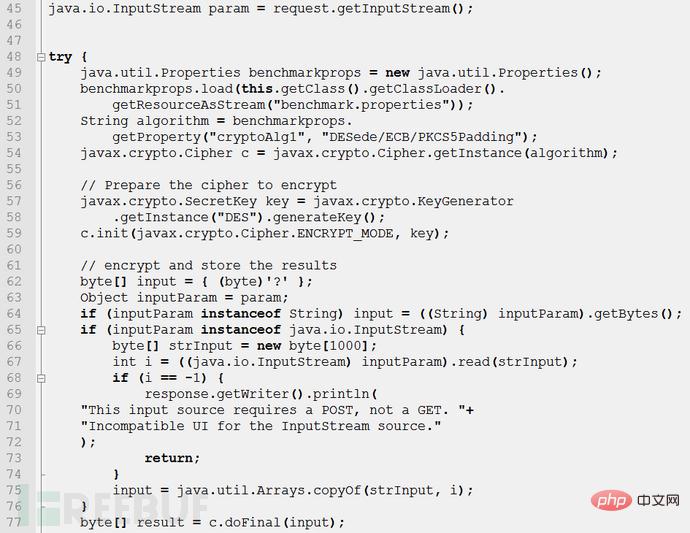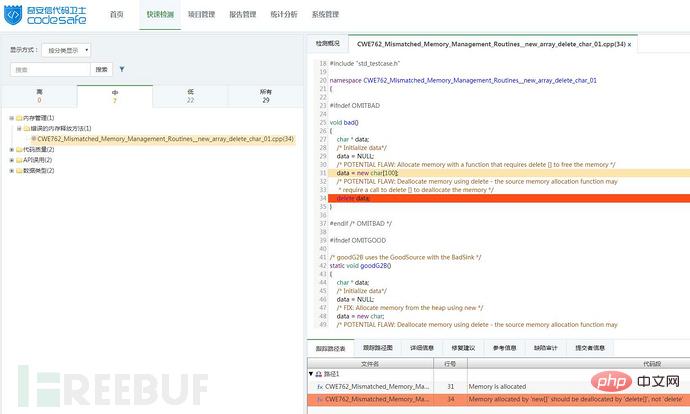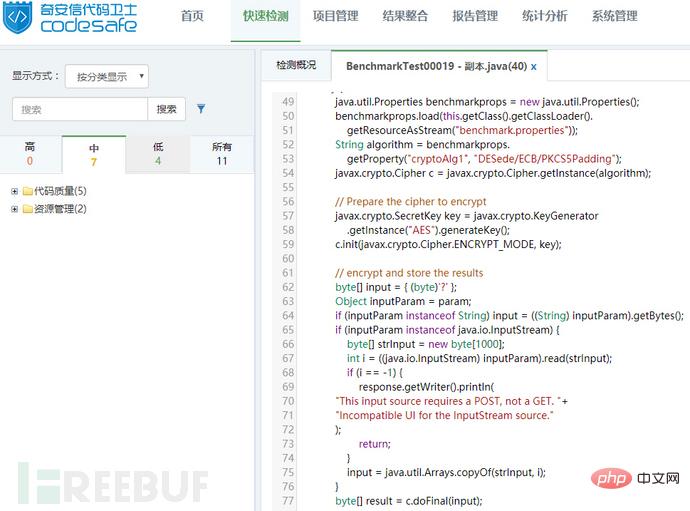How to avoid weak encryption in C language
1. Weak Encryption
Encryption refers to using a special algorithm to change the original information data, so that even if unauthorized users obtain the encrypted information, they will not know the information. The method of decryption still cannot understand the content of the message. Common encryption algorithms can be mainly divided into: symmetric encryption, asymmetric encryption, and one-way encryption. Various encryption algorithms are used in different scenarios. Choose the appropriate algorithm based on the characteristics of the encryption algorithm, such as computing speed, security, and key management methods. However, security is an important indicator to measure the quality of the encryption algorithm. Encryption that is easily cracked Algorithms are called weak encryption algorithms, such as the DES algorithm that can be cracked in a limited time using exhaustive methods. This article takes the JAVA language source code as an example to analyze the causes of weak encryption and how to repair it.
2. The dangers of weak encryption
For encryption algorithms that are weak in attack resistance, once exploited, personal privacy information may be leaked and even property losses may occur. From January 2018 to April 2019, there were a total of 2 vulnerability information related to it in CVE. The vulnerability information is as follows:
| Vulnerability Overview | |
|---|---|
| Weak encryption is used when transmitting passwords in CA Privileged AccessManager 2.x, which reduces the complexity of password cracking. | |
| In Easy Hosting Control Panel (EHCP) v0.37.12.b, it makes it easier for attackers to Crack database password. |
3. Sample code
The sample code used below comes from Benchmark (https://www.owasp.org/index .php/Benchmark), source file name: BenchmarkTest00019.java.3.1 Defect code

benchmarkprops. Load the configuration file on line 50, and read the attribute cryptoAlg1 in the configuration file on lines 52 to 53. If there is no such attribute, the default is to use DESede/ECB/PKCS5Padding to algorithm Assignment. Line 54 will use algorithm as the encryption algorithm to construct the encryption object c. Next prepare the encrypted password. Lines 57~58 instantiate a key generator for the DES encryption algorithm. Line 59 specifies that the operation mode of encryption object c is encryption, where key is the key. Lines 62 to 76 convert the input stream in the request into a byte array input, and line 77 encrypts the input. The encryption result is a byte array result. The key generated using the DES algorithm is short, only 56 bits, and the operation speed is slow. Moreover, the DES algorithm completely relies on the key and is vulnerable to exhaustive search attacks.

3.2 Repair Code


##Figure 2: Detection results after repair
In systems with high security requirements, it is recommended to use secure encryption algorithms (such as AES, RSA) to encrypt sensitive data.
The above is the detailed content of How to avoid weak encryption in C language. For more information, please follow other related articles on the PHP Chinese website!

Hot AI Tools

Undresser.AI Undress
AI-powered app for creating realistic nude photos

AI Clothes Remover
Online AI tool for removing clothes from photos.

Undress AI Tool
Undress images for free

Clothoff.io
AI clothes remover

Video Face Swap
Swap faces in any video effortlessly with our completely free AI face swap tool!

Hot Article

Hot Tools

Notepad++7.3.1
Easy-to-use and free code editor

SublimeText3 Chinese version
Chinese version, very easy to use

Zend Studio 13.0.1
Powerful PHP integrated development environment

Dreamweaver CS6
Visual web development tools

SublimeText3 Mac version
God-level code editing software (SublimeText3)

Hot Topics
 C language data structure: data representation and operation of trees and graphs
Apr 04, 2025 am 11:18 AM
C language data structure: data representation and operation of trees and graphs
Apr 04, 2025 am 11:18 AM
C language data structure: The data representation of the tree and graph is a hierarchical data structure consisting of nodes. Each node contains a data element and a pointer to its child nodes. The binary tree is a special type of tree. Each node has at most two child nodes. The data represents structTreeNode{intdata;structTreeNode*left;structTreeNode*right;}; Operation creates a tree traversal tree (predecision, in-order, and later order) search tree insertion node deletes node graph is a collection of data structures, where elements are vertices, and they can be connected together through edges with right or unrighted data representing neighbors.
 The truth behind the C language file operation problem
Apr 04, 2025 am 11:24 AM
The truth behind the C language file operation problem
Apr 04, 2025 am 11:24 AM
The truth about file operation problems: file opening failed: insufficient permissions, wrong paths, and file occupied. Data writing failed: the buffer is full, the file is not writable, and the disk space is insufficient. Other FAQs: slow file traversal, incorrect text file encoding, and binary file reading errors.
 CS-Week 3
Apr 04, 2025 am 06:06 AM
CS-Week 3
Apr 04, 2025 am 06:06 AM
Algorithms are the set of instructions to solve problems, and their execution speed and memory usage vary. In programming, many algorithms are based on data search and sorting. This article will introduce several data retrieval and sorting algorithms. Linear search assumes that there is an array [20,500,10,5,100,1,50] and needs to find the number 50. The linear search algorithm checks each element in the array one by one until the target value is found or the complete array is traversed. The algorithm flowchart is as follows: The pseudo-code for linear search is as follows: Check each element: If the target value is found: Return true Return false C language implementation: #include#includeintmain(void){i
 C language multithreaded programming: a beginner's guide and troubleshooting
Apr 04, 2025 am 10:15 AM
C language multithreaded programming: a beginner's guide and troubleshooting
Apr 04, 2025 am 10:15 AM
C language multithreading programming guide: Creating threads: Use the pthread_create() function to specify thread ID, properties, and thread functions. Thread synchronization: Prevent data competition through mutexes, semaphores, and conditional variables. Practical case: Use multi-threading to calculate the Fibonacci number, assign tasks to multiple threads and synchronize the results. Troubleshooting: Solve problems such as program crashes, thread stop responses, and performance bottlenecks.
 How to output a countdown in C language
Apr 04, 2025 am 08:54 AM
How to output a countdown in C language
Apr 04, 2025 am 08:54 AM
How to output a countdown in C? Answer: Use loop statements. Steps: 1. Define the variable n and store the countdown number to output; 2. Use the while loop to continuously print n until n is less than 1; 3. In the loop body, print out the value of n; 4. At the end of the loop, subtract n by 1 to output the next smaller reciprocal.
 How debian readdir integrates with other tools
Apr 13, 2025 am 09:42 AM
How debian readdir integrates with other tools
Apr 13, 2025 am 09:42 AM
The readdir function in the Debian system is a system call used to read directory contents and is often used in C programming. This article will explain how to integrate readdir with other tools to enhance its functionality. Method 1: Combining C language program and pipeline First, write a C program to call the readdir function and output the result: #include#include#include#includeintmain(intargc,char*argv[]){DIR*dir;structdirent*entry;if(argc!=2){
 The concept of c language functions and their definition format
Apr 03, 2025 pm 11:33 PM
The concept of c language functions and their definition format
Apr 03, 2025 pm 11:33 PM
C language functions are reusable code blocks, receive parameters for processing, and return results. It is similar to the Swiss Army Knife, powerful and requires careful use. Functions include elements such as defining formats, parameters, return values, and function bodies. Advanced usage includes function pointers, recursive functions, and callback functions. Common errors are type mismatch and forgetting to declare prototypes. Debugging skills include printing variables and using a debugger. Performance optimization uses inline functions. Function design should follow the principle of single responsibility. Proficiency in C language functions can significantly improve programming efficiency and code quality.
 How to define the call declaration format of c language function
Apr 04, 2025 am 06:03 AM
How to define the call declaration format of c language function
Apr 04, 2025 am 06:03 AM
C language functions include definitions, calls and declarations. Function definition specifies function name, parameters and return type, function body implements functions; function calls execute functions and provide parameters; function declarations inform the compiler of function type. Value pass is used for parameter pass, pay attention to the return type, maintain a consistent code style, and handle errors in functions. Mastering this knowledge can help write elegant, robust C code.






